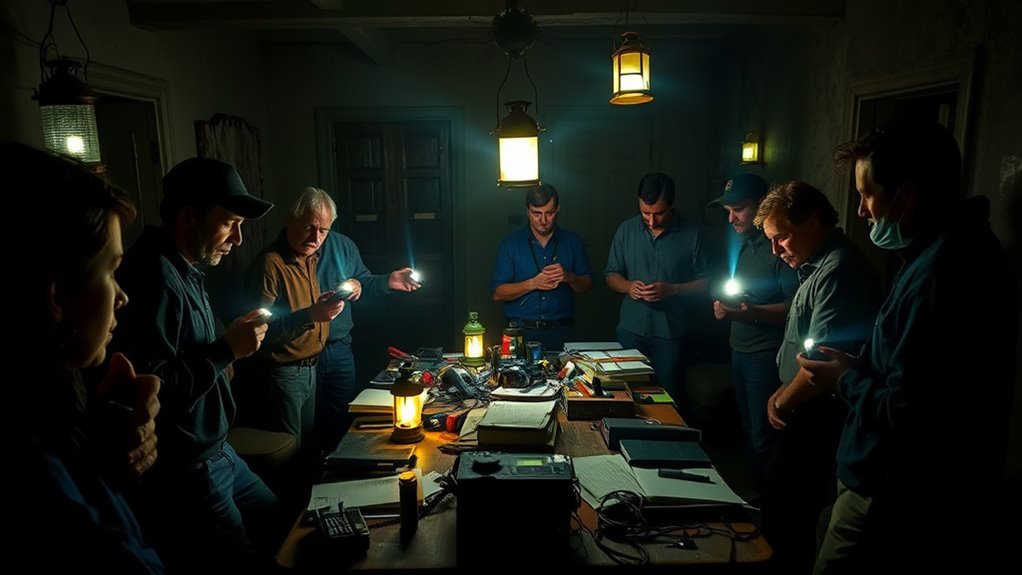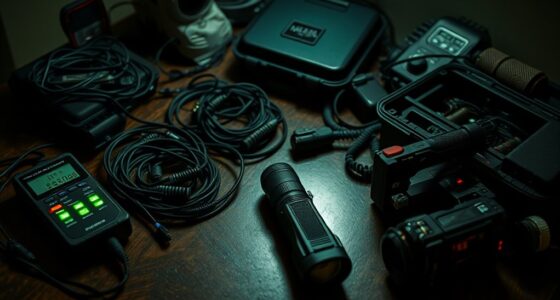You can guarantee smooth crew coordination during multi-night investigations by establishing clear communication protocols and assigning specific roles upfront. Use simple signals, frequent check-ins, and reliable technology to share updates and observations. Maintain organized records and conduct regular briefings to adapt plans as needed. Prioritize team well-being and foster open dialogue to handle unexpected challenges, making adjustments swiftly. Staying organized and flexible keeps your investigation on track—continue to explore how these strategies enhance your teamwork.
Key Takeaways
- Establish clear communication protocols and roles for each team member at the start of the investigation.
- Use standardized signals and digital tools for real-time updates and documentation across multiple nights.
- Conduct regular check-ins and debriefings to review progress, address issues, and adapt plans promptly.
- Maintain organized records and shared platforms to ensure consistent information flow and accessibility.
- Prioritize team well-being and safety with ongoing assessments, breaks, and positive reinforcement to sustain morale.
Establishing Clear Communication Protocols
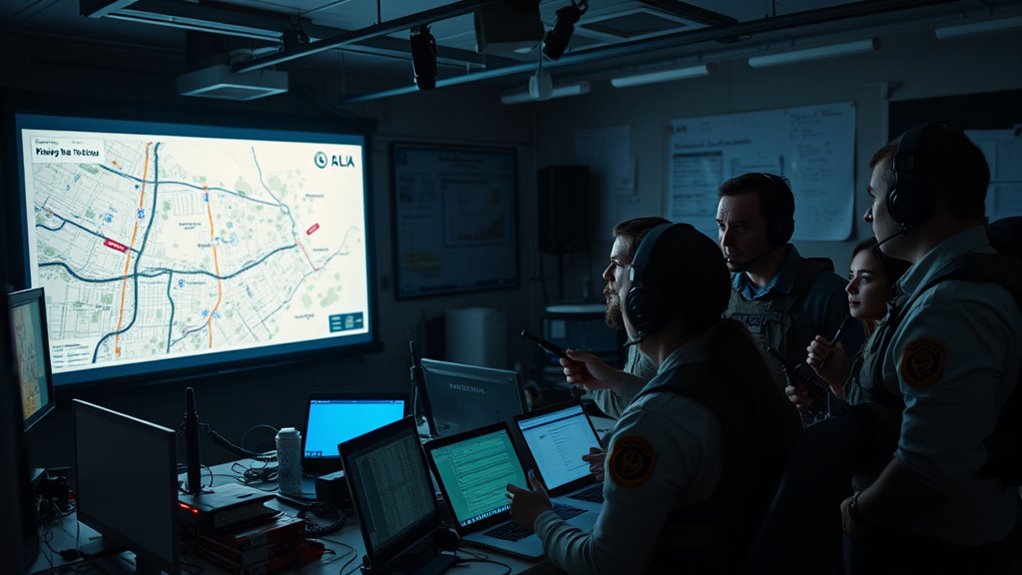
Clear communication is essential for the safety and efficiency of multi-night investigations. You need a system that keeps everyone on the same page, regardless of shifts or fatigue. Start by establishing standardized signals for key actions, such as moving to a new location or calling for assistance. Use clear, simple language and avoid jargon that could cause confusion. Make sure each team member knows their communication responsibilities and the channels they should use—whether radios, hand signals, or written notes. Regular check-ins help confirm everyone’s status and clarify plans. Document your protocols and review them regularly, especially before each night begins. Consistent communication practices are crucial for effective team coordination and overall success. This consistency reduces misunderstandings and keeps your team coordinated, allowing a smooth, safe investigation across multiple nights.
Assigning Roles and Responsibilities

Assigning roles and responsibilities at the start of each investigation guarantees everyone knows their specific tasks and areas of focus. Clear assignments prevent confusion and guarantee efficient progress. To help visualize, consider this example:
| Role | Responsibilities | Key Skills |
|---|---|---|
| Lead Investigator | Oversee entire operation, make decisions | Leadership, decision-making |
| Tech Specialist | Manage equipment, record data | Technical expertise |
| Evidence Coordinator | Organize and catalog findings | Organization, attention to detail |
| Safety Officer | Monitor safety protocols, respond to emergencies | Alertness, crisis management |
This clarity helps team members stay focused, reduces overlaps, and keeps everyone aligned toward your investigation goals. Additionally, understanding the cost factors involved can help with resource allocation and planning.
Developing a Detailed Investigation Plan
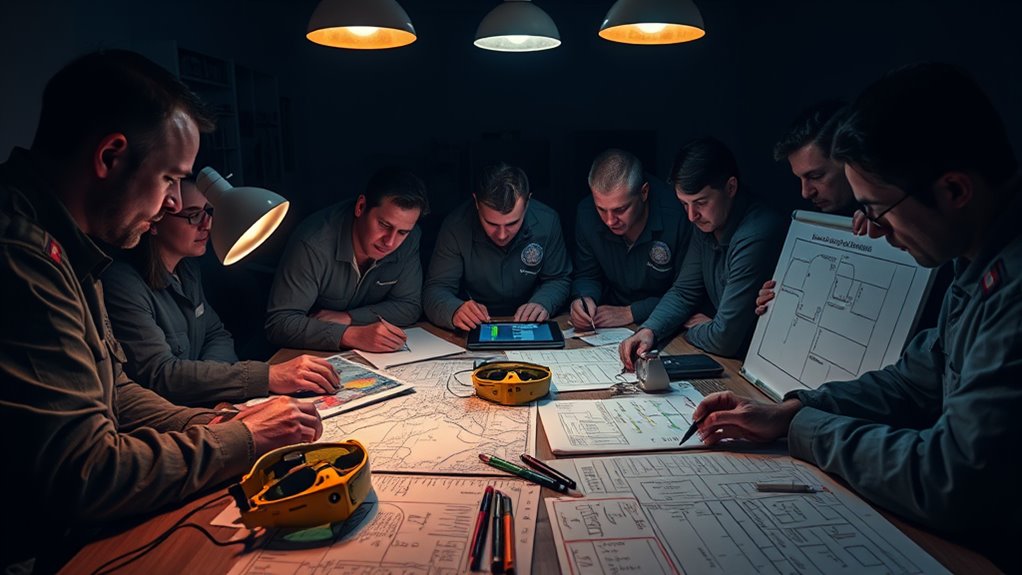
Creating a detailed investigation plan is essential for guiding your team’s efforts and ensuring a systematic approach. Start by clearly defining your investigation’s objectives, scope, and timeline. Break down each phase, outlining specific tasks, resources needed, and key milestones. Assign responsibilities for each task to team members based on their expertise, ensuring accountability. Incorporate procedures for data collection, analysis, and communication channels to keep everyone informed. Consider potential challenges and develop contingency plans to address them efficiently. A well-structured plan keeps your team focused and minimizes confusion during multi-night efforts. Regularly review and refine the plan as new information emerges, maintaining flexibility without losing sight of your primary goals. This preparation will streamline your investigation and boost team coordination. Additionally, effective communication is vital to ensure all team members stay aligned and informed throughout the process.
Maintaining Consistent Documentation and Record-Keeping
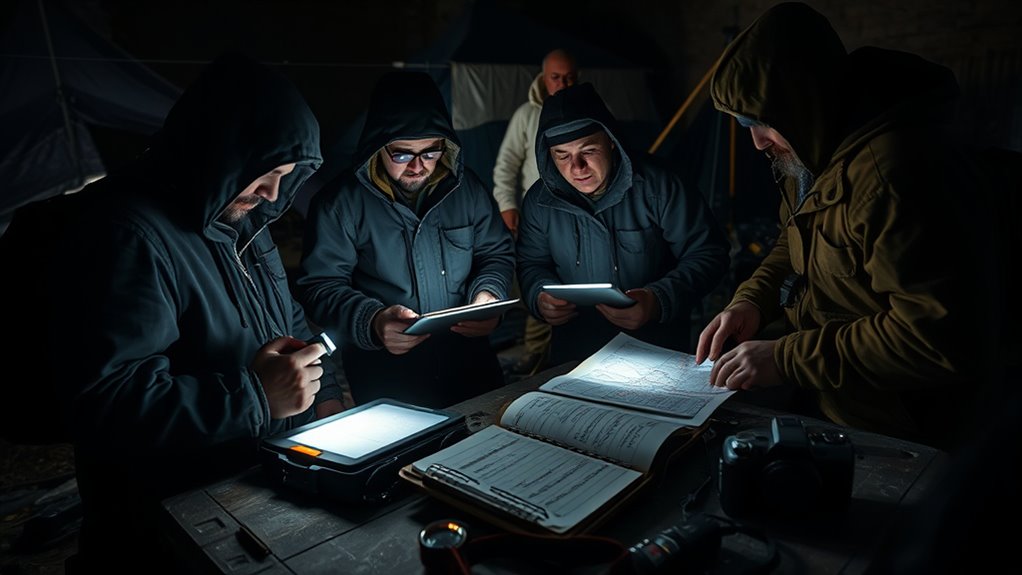
You need to keep your records organized with a clear system that everyone understands. Regular documentation checks help catch errors early and guarantee consistency across all team members. By staying on top of your record-keeping, you make the investigation smoother and more reliable. Incorporating vetted protocols ensures that all documentation meets established standards for accuracy and completeness.
Organized Record Systems
Maintaining organized record systems is essential for guaranteeing that all data collected during multi-night investigations is accurate, accessible, and easy to review. You should develop a standardized filing system, using clear labels and consistent formats for notes, photos, and logs. Digital tools like spreadsheets and cloud storage help keep records secure and searchable, allowing quick retrieval of specific information. Keep detailed logs of each team member’s observations, equipment usage, and environmental conditions, updating them daily. Regularly back up data to prevent loss. Assign specific team members responsibility for maintaining the system to ensure consistency. Clear organization minimizes confusion, reduces errors, and streamlines collaboration, making it easier to analyze findings and prepare reports efficiently during and after the investigation. Utilizing effective record-keeping practices can significantly improve overall data management and team coordination.
Regular Documentation Checks
Regular documentation checks are essential for ensuring that records remain accurate, complete, and up-to-date throughout multi-night investigations. You should establish a routine to review logs, notes, and data entries at regular intervals. This helps catch errors early, preventing discrepancies from compounding over time. Make sure all team members understand the importance of consistent record-keeping and follow standardized formats. During checks, verify that all information is legible, correctly labeled, and aligned with the investigation’s protocols. Address any gaps or inconsistencies immediately, and update records as needed. Regular reviews promote transparency and accountability, making it easier to track progress and share accurate information with the team. Staying vigilant with documentation guarantees the integrity and reliability of your investigation’s overall data. Incorporating standardized formats can further improve consistency and clarity across all records.
Conducting Regular Team Briefings and Debriefings
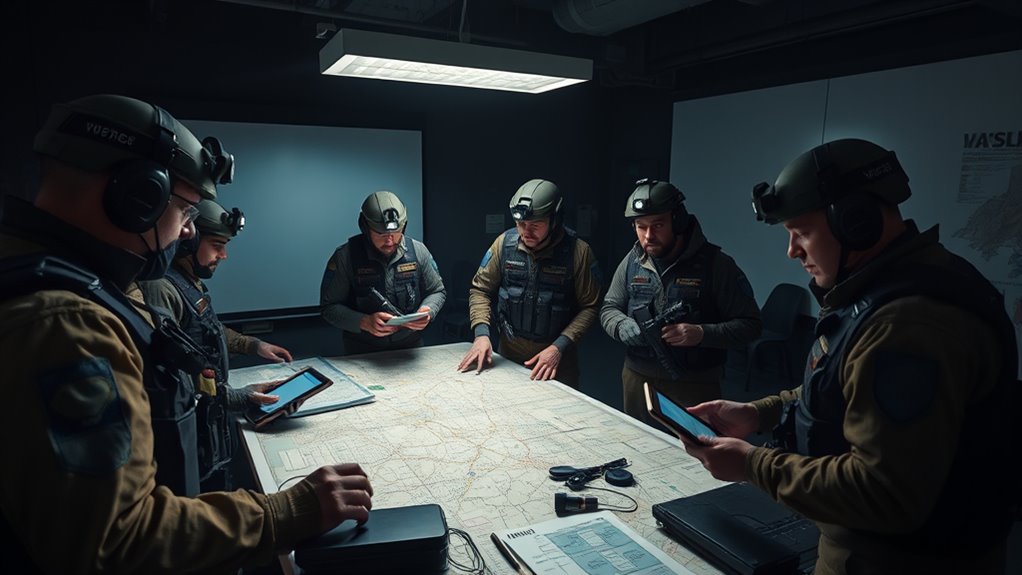
Conducting team briefings and debriefings consistently guarantees everyone stays aligned and prepared for each night’s investigation. These sessions help clarify goals, assign tasks, and address concerns promptly. Regular communication prevents misunderstandings and ensures team cohesion. Use the table below to structure your meetings effectively:
| Session Type | Focus Areas | Key Participants |
|---|---|---|
| Briefings | Objectives, plans | Entire team, leads |
| Debriefings | Outcomes, issues | All members, supervisors |
| Preparation | Equipment, safety | Field team, support staff |
| Follow-up | Action items, improvements | Team leads, analysts |
Stick to this framework to keep everyone informed, engaged, and ready to tackle each night’s challenges efficiently. Additionally, incorporating transparent communication into your protocols can enhance trust and team synchronization during investigations.
Utilizing Technology for Effective Information Sharing

Using technology can considerably improve how your team shares information during multi-night investigations. Real-time data sharing keeps everyone updated instantly, reducing miscommunication. Cloud-based collaboration tools enable your crew to access and contribute data from anywhere, ensuring seamless coordination. Implementing effective filtration and pump protection strategies in your equipment maintenance can also prevent delays and ensure smooth operations throughout the investigation.
Real-Time Data Sharing
How can investigators guarantee everyone stays on the same page during multi-night investigations? The key is real-time data sharing. Using mobile devices and specialized apps, your team can instantly update and access vital information, such as new findings, location logs, or equipment status. This keeps everyone informed, reduces miscommunication, and speeds decision-making. Consider this table:
| Data Type | Sharing Method |
|---|---|
| Observations | Live notes via secure app |
| Photos & Videos | Instant uploads to shared platform |
| Equipment Data | Real-time status updates |
Additionally, leveraging reliable technology ensures seamless communication across different locations.
Cloud-Based Collaboration
Cloud-based collaboration tools enable your team to share and access information seamlessly across multiple nights of investigation. These platforms allow you to upload photos, videos, notes, and data in real-time, guaranteeing everyone stays updated regardless of location. With centralized storage, you avoid version control issues and reduce the risk of losing critical information. Your team can comment, tag, and organize files for easy retrieval, streamlining communication. Mobile access ensures you can review findings in the field or back at base camp, keeping everyone synchronized. Cloud collaboration also facilitates task assignment and progress tracking, promoting accountability. By harnessing this technology, you minimize miscommunication and maximize efficiency during multi-night investigations, making your team’s efforts more coordinated and effective. Incorporating security measures such as encryption and access controls ensures sensitive investigation data remains protected throughout your collaborative efforts.
Adapting to Changing Conditions and Unexpected Challenges
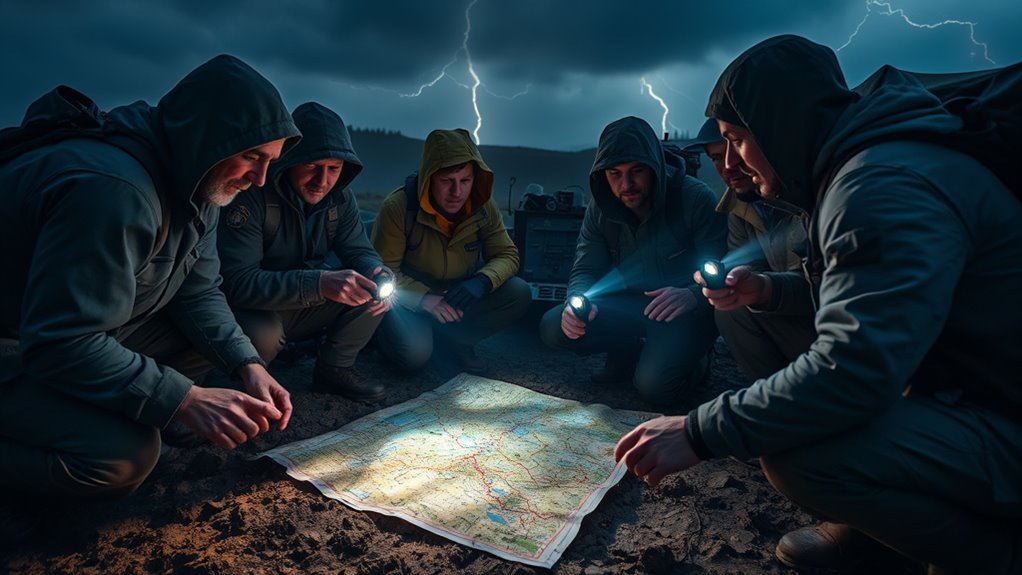
Adaptability is essential when investigating paranormal activity over multiple nights, as conditions can shift unexpectedly and throw off even the most prepared team. You need to stay alert and flexible, ready to modify your approach based on new evidence or environmental changes. If equipment malfunctions or strange phenomena occur unexpectedly, don’t panic—assess the situation calmly and adjust your strategy accordingly. Communication becomes even more critical during these moments; share observations quickly and coordinate responses effectively. Sometimes, you might need to change locations or alter your investigative focus. Maintaining a mindset of problem-solving rather than frustration helps keep the team cohesive. By staying adaptable, you ensure that surprises don’t derail your investigation, allowing you to gather valuable data despite unforeseen challenges.
Ensuring Team Well-Being and Morale

Managing team well-being and morale is vital when investigating over multiple nights, especially as unexpected challenges and changing conditions can take a toll on everyone’s mental and physical state. You should regularly check in with team members, encouraging open communication about fatigue, stress, or concerns. Create a supportive environment where everyone feels valued and heard, which boosts overall morale. Incorporate short breaks, nutritious snacks, and hydration to maintain energy levels. Recognize individual efforts and celebrate small successes to foster motivation. Keep a positive attitude and lead by example, demonstrating resilience and calmness. When team members feel cared for and understood, they’re more likely to stay engaged, focused, and resilient through the demanding nature of multi-night investigations.
Reviewing and Refining Procedures After Each Night

After each night of investigation, it’s essential to review what worked well and identify areas for improvement. Gather your team quickly and discuss observations openly. Focus on communication effectiveness, safety protocols, and equipment performance. Address any issues that arose and consider how procedures can be adjusted for better efficiency. Keep notes of lessons learned to prevent repeating mistakes. Encourage team members to share their insights honestly, fostering a culture of continuous improvement. Refine your protocols accordingly, ensuring everyone is clear on updates before the next night. This ongoing review process helps maintain high standards, adapt to new challenges, and build team confidence. Consistent reflection makes your investigation more organized, safe, and productive over multiple nights.
Frequently Asked Questions
How Do Team Members Handle Conflicts During Long Investigations?
When conflicts arise during long investigations, you should address them promptly and calmly. Listen carefully to each person’s perspective, then find common ground and agree on a solution. Keep communication open and respectful, and don’t let frustrations build up. If needed, involve a team leader or mediator to help resolve issues quickly. Staying professional and focused on your shared goal ensures the team stays effective and cohesive.
What Strategies Improve Team Cohesion Over Multiple Nights?
Think of your team as a symphony—cohesion improves when everyone stays in tune. To strengthen bonds over multiple nights, communicate openly, share experiences, and set clear roles. Encourage debriefs after each shift to address concerns and celebrate successes. Building trust through consistency and empathy keeps everyone aligned, much like a well-conducted orchestra. These strategies make your team more resilient, unified, and ready to tackle any challenge together.
How Is Information Confidentiality Maintained Across Shifts?
You maintain information confidentiality across shifts by implementing secure protocols like encrypted communication channels and restricted access to sensitive data. Always remind team members about confidentiality policies and ensure they understand the importance of discretion. Use clear documentation procedures to track information sharing, and verify that only authorized personnel access critical details. Regularly review confidentiality practices to address potential vulnerabilities and uphold trust within your investigative team.
What Training Is Recommended for New Team Members?
You should undergo thorough training that covers investigation protocols, safety procedures, and confidentiality policies. Focus on effective communication skills, technical tools, and team collaboration. Shadow experienced team members to learn best practices firsthand. Regular refreshers and scenario-based exercises help reinforce knowledge. Make certain you understand data handling and security measures. This preparation ensures you’re confident, efficient, and aligned with team standards during multi-night investigations.
How Do Teams Manage Fatigue and Prevent Burnout?
To manage fatigue and prevent burnout, you should prioritize regular breaks and maintain open communication about how you’re feeling. It’s crucial to listen to your body and encourage your team to do the same. By fostering a supportive environment, you help everyone recharge and stay alert. Remember, caring for your well-being ensures the team remains strong, focused, and ready to face each night’s challenges with renewed energy.
Conclusion
By building bridges through clear communication, coordinated roles, and consistent collaboration, you guarantee a successful multi-night investigation. Embrace adaptability, maintain morale, and meticulously monitor your methods to master the mysteries. Every evening’s effort enhances expertise, empowering your team to uncover truths with confidence and cohesion. Remember, thoroughness and teamwork transform challenges into cherished chapters of your investigative chronicle, creating a engaging, cohesive, and enthralling conclusion to each night’s quest.
